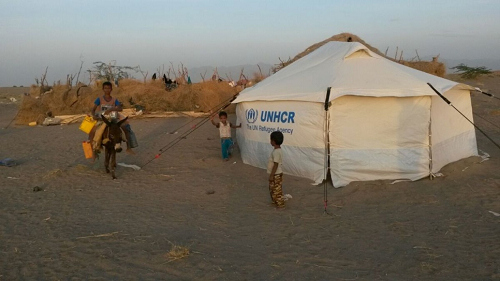Yemen’s Brutal Conflict Pushing One Million Displaced to Return to Danger (Joint UNHCR-IOM Press Release)
Unabated conflict and rapidly deteriorating conditions across Yemen are pushing millions of displaced Yemenis further into danger and adversity, UNHCR, the UN Refugee Agency, and IOM, the UN Migration Agency, warned following the release of the latest data on the country’s displacement crisis, on February21.

As fighting spreads in Yemen in February 2017, a recently displaced family receives UNHCR assistance, a tent to live in, in the coastal governate of Al Hudaydah. Some 34,000 people fled their homes in Al Mokha and Dhubab districts as the conflict intensified.
Since the beginning of the conflict in March 2015, more than 11 per cent of Yemen’s population, some 3 million people, have been forced to flee their homes for safety. Almost two years later, however, prolonged hostilities and worsening conditions are now forcing 1 million of those uprooted to return to the homes from which they fled, despite danger and insecurity across the country.
Two reports issued by the Task Force on Population Movement (TFPM), a technical working group co-led by UNHCR and IOM, show that there are currently 2 million internally displaced people (IDPs) across Yemen and 1 million IDP returnees; and that as conditions across the country further deteriorate, many more IDPs are contemplating a return home, where challenging security and socio-economic conditions persist.
Comprising a Multi-sectoral Location Assessment report released on February21, and a periodically updated population movement tracking report (TFPM 12th report) published last month, the TFPM reports furnish the most comprehensive and detailed estimates of displaced populations and their circumstances in Yemen, and inform humanitarian response planning for 2017.
The reports highlight that a lack of access to income and basic services in areas of displacement are the main reasons pushing IDPs to return to their areas of origin, with 40 per cent of key informants indicating that IDPs now intend to return home within the next three months.
UNHCR’s Country Representative for Yemen, Ayman Gharaibeh, said: “It’s testament to how catastrophic the situation in Yemen has become, that those displaced by the conflict are now returning home because life in the areas to which they had fled for safety is just as abysmal as in the areas from which they fled.”
“Those attempting to return face tremendous challenges,” Gharaibeh added. “They often return to homes that have been damaged, in areas lacking essential services. They still need humanitarian aid and are often forced to flee their homes again. These returns cannot be viewed as sustainable.”
Noting that all of Yemen’s governorates, with the exception of the island of Socotra, have been affected by conflict, Gharaibeh said, “the overwhelming majority of Yemen’s 1 million IDP returnees have returned to Aden, Amanat Al Asimah, Taizz, Lahj and Shabwah, which have been particularly impacted by hostilities and insecurity.”
“For those that are returning home, food, financial assistance and psycho-social support remain priority needs,” he added.
The TFPM reports also provide indications of how dire life has become for the 2 million IDPs across the country. Shortages of food and malnutrition are widespread and reported in 84 per cent of IDP locations identified. In addition to malnutrition, diarrheal diseases and malaria are cited as the most common health concerns for Yemen’s displaced.
IOM Yemen’s Chief of Mission, Laurent De Boeck, noted the great distress for those in collective centers and spontaneous settlements, explaining that “IOM, alongside its partners, remains committed to support IDP families who have sought shelter in these camp-like settings and are living in unbearable conditions with limited to no access to services and are exposed to health risks and environmental hazards on a daily basis.”
Source: United Nations High Commissioner for Refugees
- 278 reads
Human Rights
Fostering a More Humane World: The 28th Eurasian Economic Summi

Conscience, Hope, and Action: Keys to Global Peace and Sustainability

Ringing FOWPAL’s Peace Bell for the World:Nobel Peace Prize Laureates’ Visions and Actions

Protecting the World’s Cultural Diversity for a Sustainable Future

Puppet Show I International Friendship Day 2020

